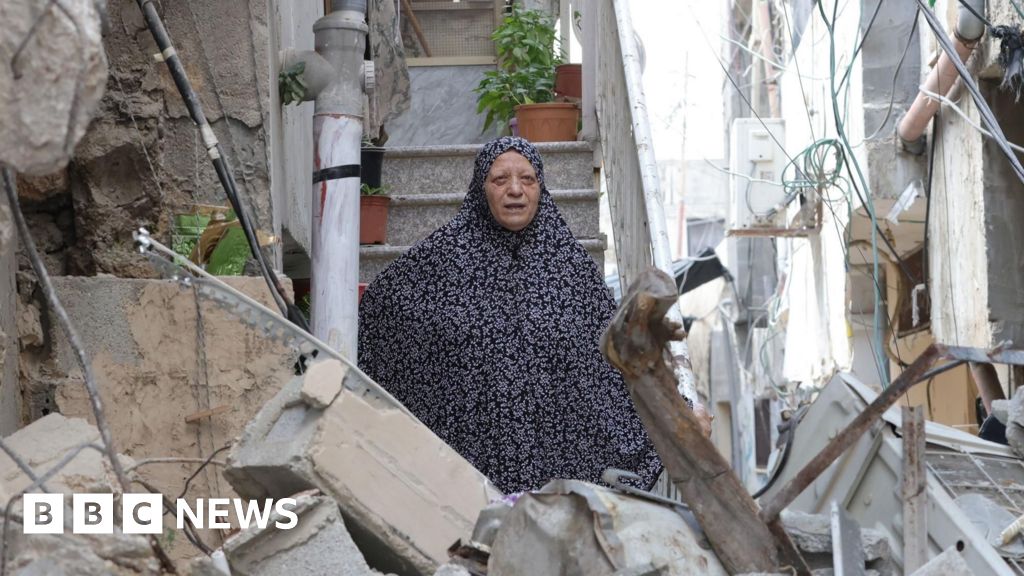 Alaa Badarneh
Alaa BadarnehMajdi was in his house at the entrance of Nur Shams refugee camp when the Israeli armoured bulldozers came.
He told his three children not to be scared as the bulldozer pushed up against their front wall, smashing through the staircase and balcony.
“The bulldozer kept coming closer to the house,” he said. “It lifted the rubble near those two windows above. It was trying to hit them.”
Residents living near the entrances to Nur Shams often leave when they hear the Israeli army is coming. I asked Majdi why he stayed.
“Why would I leave?” he said.
“We won’t leave. We are staying here. We either go back to our lands [in what is now Israel] or stay here and die. There are no other options.”
At least four men were killed in the Tulkarm area, which includes Nur Shams, during Israel’s two-day military operation here, including at least two who were fighting Israeli forces.
“Every time one of us is killed, 10 more are born. We are crushing them, and hopefully, our children will also crush them,” Majdi said.
 Getty Images
Getty ImagesIsrael’s army pulled out of Nur Shams camp on Friday morning, but its wider operation across the north of the occupied West Bank continues – with the aim, Israel says, of dismantling the armed groups there.
One of the men killed during the operation was 69-year-old Ayed Abu Hajja, who was disabled and a long-term resident of Nur Shams. He was shot by a sniper, neighbours said, when he opened a window in his house.
On Friday, his body was carried through the narrow streets to his mother’s home, before burial.
A large crowd of young men gathered to escort his body to the cemetery – but others were there to honour someone else.
Groups of young men filed silently past the crowd with their weapons – to a separate, symbolic burial for their leader, Mohammed Jaber – also killed during the Israeli operation in this city
The fighter and the civilian, living for years side by side in Nur Shams, remembered side by side in death. One with prayers; the other with bursts of automatic gunfire – a show of force from Tulkarm’s armed fighters, less than a day after Israel’s army withdrew.
 Reuters
ReutersInside Nur Shams, Israel’s operation has left war-like destruction in parts of the camp: houses burned out, walls sheared off.
Whole buildings collapsed into rubble have opened up new, sloping and precarious routes between the camp’s main streets.
A child of six or seven, dwarfed by a mountain of concrete boulders, reaches gently in to pick out a bright yellow toy walkie-talkie from the remains of his grandmother’s house.
Standing nearby is his grandmother’s next-door neighbour, Fadwa Abu Ayad, her path to the street cut off by the rubble mountain. The army also came to her house, she said.
 Alaa Badarneh
Alaa Badarneh“They told us that we have tunnels like in Gaza, and smuggle the armed groups to this house,” Fadwa said.
I asked her if that was true.
“It’s impossible,” she replied. “He brought a drill and dug into the floor. All he found was a sewer hole.”
Fadwa takes us through another entrance to her house, and shows us the broken floor – beneath it is a small pipe and what appears to be a sewer drain. It’s too small for a person to fit through.
“What is happening in the [West Bank] camps now is like a small version of Gaza,” Fadwa said. “Ever since 7 October,” she added, referring to the day of Hamas’s deadly attack on Israel, which triggered the war in Gaza.
 Alaa Badarneh
Alaa BadarnehDown another shattered street, paved with broken glass and burned pieces of rubble, I hear a voice at the window above me. It turns out to be Umm Yazan.
She says the army laid wires from her home to blow up two of the houses opposite – families she has known for decades.
“I have 10-year-old triplets, and they trapped us in a room,” she told me. “Then they started the explosions – five explosions in total. Imagine the walls shaking and your young children clinging to you. It feels like we’re in Gaza.”
Israel says this is a counter-terrorist operation, to dismantle Palestinian armed groups it says are funded and armed by Iran.
But Umm Yazan replies that it is the army’s responsibility to target fighters, and not involve families like hers.
“Are there fighters in my house? I have young children, my husband has an Israeli work permit. My house is a safe house.”
You hear comparisons with Gaza a lot here now.
The grinding conflict between Israel and armed Palestinian groups in the West Bank is still very different to the Gaza war, but that war has changed attitudes and tactics here – on both sides.
It has changed how Israel views the threat from armed groups here – and, some say, it is also changing its response on the ground.


